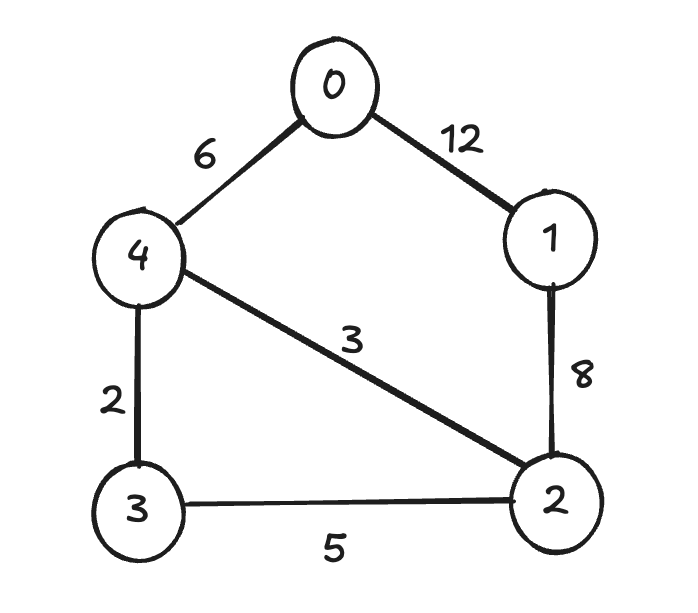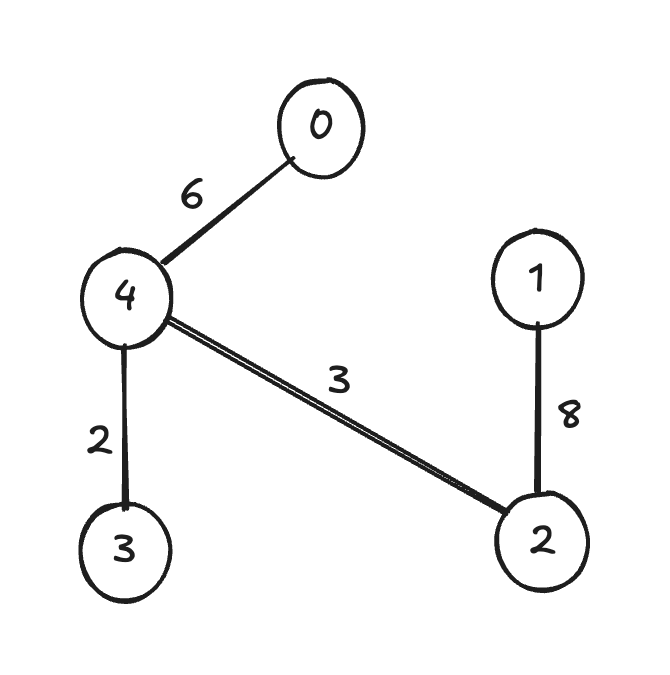Prim’s Algorithm — Minimum Spanning Tree (MST)
In this post, we will explore Prim’s Algorithm, a greedy approach used to find the Minimum Spanning Tree (MST) of a weighted, undirected graph. We’ll also implement the algorithm in Go and walk through a visual example to solidify your understanding.
When Can We Use Prim’s Algorithm?
Prim’s Algorithm can be applied only when the graph satisfies the following conditions:
- The graph is undirected
- All edge weights are non-negative
- The graph is connected (there's a path between every pair of nodes)
❗ If the graph is disconnected, Prim’s algorithm will not generate a spanning tree that includes all vertices.
What Does It Do?
Prim’s Algorithm helps us find the Minimum Spanning Tree (MST) — a subset of the edges that:
- Connects all vertices in the graph
- Has no cycles
- Has the minimum total edge weight possible
Where Is It Used in Real Life?
Prim’s Algorithm is widely used in various domains:
- Designing road and highway networks (connecting cities with minimal cost)
- Laying out cables or pipelines (least amount of wire or pipe needed to connect buildings)
- Network design (connecting routers/switches efficiently)
- Cluster analysis in machine learning
- Utility planning (electricity, water supply, etc.)
Example (With Visualization)
Here’s a visual explanation of Prim’s Algorithm:

We start with Node 0 and build the Minimum Spanning Tree (MST) by always picking the lowest-weight edge that connects a visited node to an unvisited one.
Steps:
-
Start at Node 0 Lowest edge: 0 → 4 (6) → Add to MST
-
From 4 Lowest edge: 4 → 3 (2) → Add to MST
-
From 3 Lowest edge: 4 → 2 (3) → Add to MST
-
From 2 Lowest edge: 2 → 1 (8) → Add to MST
All nodes are now connected with the minimum total weight.

The edges in teal form the Minimum Spanning Tree.
🛠️ Go Implementation
package main
import (
"container/heap"
"fmt"
)
type MinHeap [][]int
func (h MinHeap) Len() int { return len(h) }
func (h MinHeap) Less(i, j int) bool { return h[i][2] < h[j][2] }
func (h MinHeap) Swap(i, j int) { h[i], h[j] = h[j], h[i] }
func (h *MinHeap) Push(value any) { *h = append(*h, value.([]int)) }
func (h *MinHeap) Pop() any {
l := len(*h)
val := (*h)[l-1]
*h = (*h)[:l-1]
return val
}
func printMst(edges [][][]int) [][][]int {
mst := make([][][]int, len(edges))
h := &MinHeap{}
heap.Init(h)
for _, edge := range edges[0] {
heap.Push(h, []int{0, edge[0], edge[1]}) // from, to, weight
}
visited := map[int]bool{0: true}
for h.Len() > 0 {
edge := heap.Pop(h).([]int)
from, to, weight := edge[0], edge[1], edge[2]
if visited[to] {
continue
}
visited[to] = true
mst[from] = append(mst[from], []int{to, weight})
mst[to] = append(mst[to], []int{from, weight})
for _, next := range edges[to] {
if !visited[next[0]] {
heap.Push(h, []int{to, next[0], next[1]})
}
}
}
return mst
}
Sample Input
func main() {
edges := [][][]int{
{{1, 12}, {4, 6}}, // Node 0
{{0, 12}, {2, 8}}, // Node 1
{{1, 8}, {3, 5}, {4, 3}}, // Node 2
{{2, 5}, {4, 2}}, // Node 3
{{0, 6}, {2, 3}, {3, 2}}, // Node 4
}
mst := printMst(edges)
fmt.Println("Minimum Spanning Tree:")
for i, connections := range mst {
for _, conn := range connections {
fmt.Printf("%d -- %d (weight %d)\n", i, conn[0], conn[1])
}
}
}
Output
Minimum Spanning Tree:
0 -- 4 (weight 6)
1 -- 2 (weight 8)
2 -- 4 (weight 3)
2 -- 1 (weight 8)
3 -- 4 (weight 2)
4 -- 0 (weight 6)
4 -- 3 (weight 2)
4 -- 2 (weight 3)
⏱️ Time & Space Complexity
- Time Complexity:
O(E log E)due to min-heap operations - Space Complexity:
O(V + E)for the heap and adjacency list
👍 Advantages
- Efficient for dense graphs
- Easy to implement with a min-heap
- Builds MST without sorting all edges
👎 Disadvantages
- Doesn’t work on directed graphs
- Fails on graphs with negative weights
- Requires the graph to be connected
Conclusion
Prim’s Algorithm is a powerful tool for finding MSTs in undirected graphs. It’s highly practical for infrastructure design, network planning, and clustering algorithms.
🧠 Remember: Use Prim’s when the graph is undirected, connected, and all weights are non-negative.
Feel free to follow my work on GitHub: Prim's Algorithm in Go.